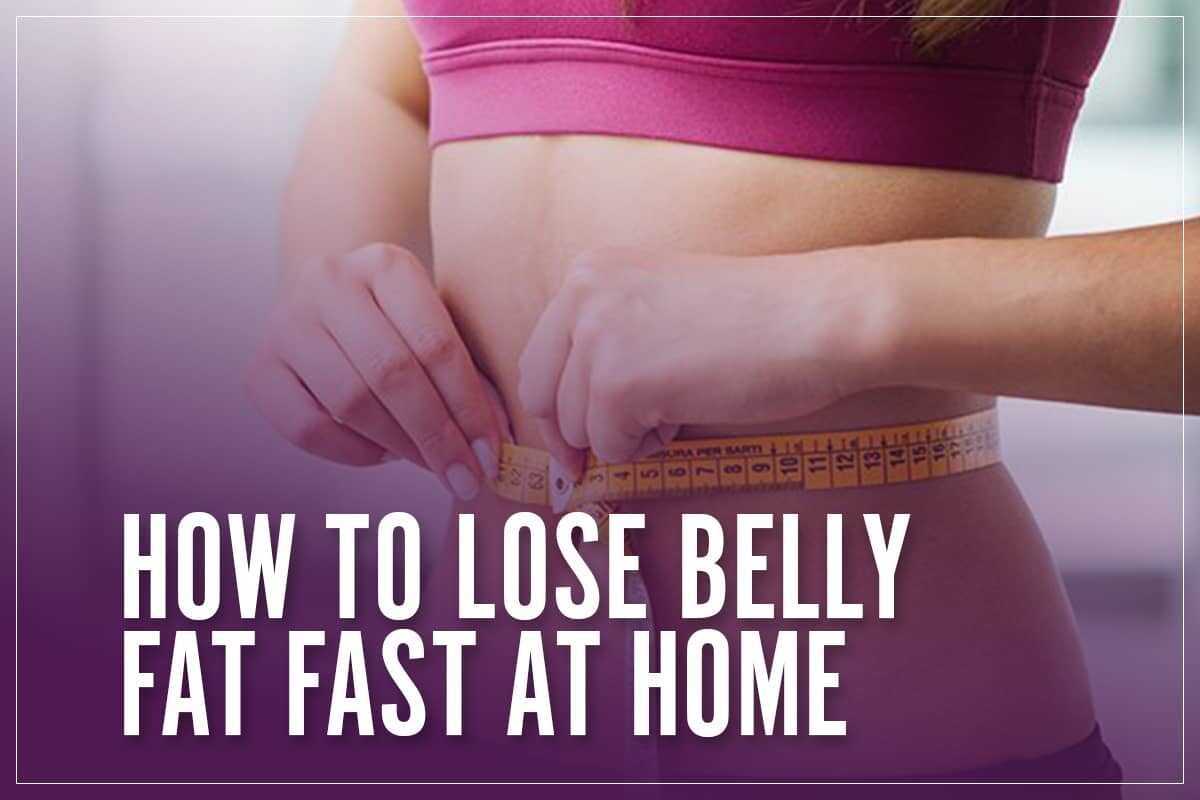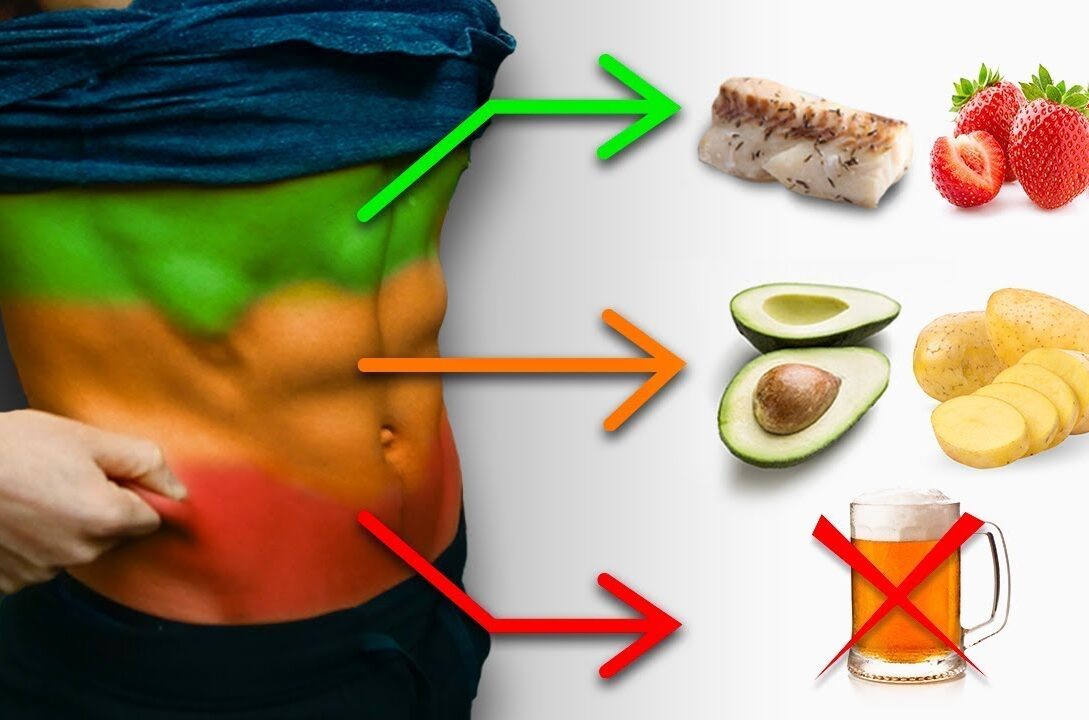To lose belly fat, incorporate a combination of regular exercise and a healthy diet. In addition to toning your midsection, this approach helps you burn calories and reduce overall body fat.
By staying consistent and making sustainable lifestyle changes, you can achieve your goal of a trimmer waistline.
What Is Belly Fat And Why It’S Important To Lose It
Belly fat is excess fat stored around the abdominal area. Losing belly fat is important for overall health as it is linked to various health risks such as heart disease and diabetes. Discover effective ways and tips on how to lose belly fat for a healthier and fitter lifestyle.
Belly fat, also known as visceral fat, is the fat that accumulates around your abdomen, surrounding your internal organs. It not only affects your appearance but can also have serious implications for your health. Understanding why it’s crucial to lose excess belly fat is the first step towards achieving a healthier lifestyle.
Importance Of Losing Excess Belly Fat For Overall Health
Excess belly fat poses numerous health risks, making it imperative to shed those extra inches. Here’s why losing belly fat is crucial for your overall well-being:
- Increased Risk of Chronic Diseases: Carrying excess belly fat is strongly associated with an increased risk of chronic conditions such as heart disease, type 2 diabetes, and certain types of cancer.
- Metabolic Health: Belly fat is metabolically active and produces hormones and chemicals that can disrupt your body’s normal functioning. Losing belly fat improves insulin sensitivity and reduces inflammation, leading to better metabolic health.
- Improved Heart Health: Belly fat releases fatty acids into the bloodstream, which can increase cholesterol levels and lead to plaque buildup in the arteries. By reducing belly fat, you can lower the risk of heart disease and stroke.
- Enhanced Lung Function: Excessive belly fat can put pressure on your diaphragm, affecting your breathing and lung function. Losing belly fat can help improve your respiratory capacity and overall lung health.
- Better Sleep Quality: Studies have shown a link between excess belly fat and sleep apnea, a condition that causes interrupted breathing during sleep. Losing belly fat can alleviate sleep apnea symptoms and improve the quality of your sleep.
- Enhanced Confidence and Mental Well-Being: Losing belly fat not only improves your physical health but also boosts your self-esteem and confidence, leading to better mental well-being. A healthy body image positively impacts your overall quality of life.
By shedding excess belly fat, you can reduce the risk of chronic diseases, enhance metabolic health, improve heart and lung function, enjoy better sleep, and experience an increase in confidence and mental well-being. Take the necessary steps to prioritize your health and embark on a journey towards a slimmer and healthier you.
Different Types Of Belly Fat
Belly fat comes in different types, such as subcutaneous and visceral fat. To lose belly fat, focus on healthy eating, regular exercise, and lifestyle changes. Emphasize whole foods, reduce calorie intake, and incorporate aerobic and strength-training exercises into your routine.
Belly fat, also known as abdominal fat, is not created equal. There are two main types of belly fat: subcutaneous fat and visceral fat. Understanding the differences between these fat types is essential for effectively losing belly fat and improving your overall health.
Subcutaneous Fat Vs Visceral Fat And Their Impact On Health
**Subcutaneous Fat:**
- This type of fat sits directly beneath the skin and is the most visible form of belly fat.
- It is relatively harmless and tends to be more of a cosmetic concern than a health risk.
- Subcutaneous fat can be pinched and felt, giving the abdomen a soft and jiggly appearance.
- While excessive subcutaneous fat is linked to a higher risk of obesity-related diseases, such as heart disease and diabetes, it is not considered as dangerous as visceral fat.
**Visceral Fat:**
- Visceral fat is hidden beneath the abdominal muscles and wraps around vital organs like the liver, pancreas, and intestines.
- It is the more dangerous type of belly fat as it produces hormones and chemicals that can disrupt the normal functioning of the body.
- Visceral fat is associated with increased risks of heart disease, stroke, type 2 diabetes, and certain types of cancer.
- Unlike subcutaneous fat, visceral fat cannot be easily pinched or felt.
Understanding the differences between subcutaneous fat and visceral fat is crucial for addressing belly fat and prioritizing your health. While subcutaneous fat may cause aesthetic concerns, it is visceral fat that poses the greatest health risks. By adopting healthy lifestyle habits, including a balanced diet and regular exercise, you can effectively reduce both types of belly fat and improve your overall well-being.
The Science Behind Belly Fat Accumulation
Belly fat accumulation is influenced by various scientific factors, including genetics and lifestyle choices. To lose belly fat, it is important to incorporate a balanced diet, regular exercise, and stress management techniques into your daily routine. With consistency and dedication, you can achieve a healthier and trimmer waistline.
Belly fat is a common concern for many individuals. Not only does it affect one’s appearance, but it also poses various health risks. Therefore, understanding the science behind belly fat accumulation is crucial. In this section, we will delve into how excess calories contribute to belly fat and the role of hormones in belly fat storage.
How Excess Calories Contribute To Belly Fat:
- Consuming more calories than your body requires leads to weight gain, including an accumulation of belly fat.
- Excess calories are stored as fat in various areas of the body, and the abdominal area is particularly prone to this accumulation.
- When you consistently consume more calories than you burn, the excess energy is stored in fat cells, causing them to expand and accumulate in the belly region.
- Additionally, a diet high in processed foods, sugary drinks, and unhealthy fats contributes to belly fat accumulation.
Role Of Hormones In Belly Fat Storage:
- Hormones play a significant role in regulating fat storage and distribution throughout the body, including the belly area.
- Insulin, a hormone produced by the pancreas, plays a crucial role in regulating blood sugar levels. When insulin levels are consistently elevated due to factors like consuming excessive amounts of sugar and refined carbohydrates, it promotes fat storage, particularly in the abdominal region.
- Cortisol, commonly known as the stress hormone, is also linked to belly fat accumulation. Chronic stress leads to increased cortisol production, which can result in the storage of excess fat in the abdominal area.
- Estrogen imbalance in both men and women can contribute to belly fat accumulation as well. High levels of estrogen in men due to various factors, such as obesity or hormonal disorders, can lead to central adiposity.
- Additionally, gender-specific hormones, such as testosterone in men and progesterone in women, influence fat distribution and may affect belly fat levels.
Understanding the science behind belly fat accumulation is essential for devising effective strategies to target and reduce belly fat. By addressing the role of excess calories and hormonal imbalances, individuals can make informed lifestyle changes and adopt healthy habits to achieve their desired results.
Setting Realistic Weight Loss Goals
Setting realistic weight loss goals is crucial when it comes to losing belly fat. By avoiding overused phrases and focusing on achievable targets, you can stay motivated and see sustainable results in your journey towards a healthier body.
Understanding Healthy Weight Loss Rates:
Losing belly fat is a common health goal for many individuals. However, it is important to approach weight loss in a healthy and sustainable manner. Understanding the concept of healthy weight loss rates is crucial to avoid any potential harm or disappointment along the way.
Here are some key points to keep in mind:
- Gradual progress: It is recommended to aim for a weight loss rate of 1-2 pounds per week. This gradual approach allows your body to adapt and avoid unnecessary strain.
- Sustainable lifestyle changes: Fad diets or extreme calorie restrictions may result in quick weight loss initially, but they are often difficult to maintain in the long run. Focus on making sustainable changes to your eating habits and incorporating regular physical activity.
- Individual differences: Everyone’s body is unique, and weight loss rates may vary depending on factors such as age, gender, metabolism, and overall health. It’s essential to be patient and not compare your progress with others.
- Consult a healthcare professional: Before embarking on any weight loss journey, it’s advisable to consult with a healthcare professional. They can assess your specific needs and provide guidance tailored to your individual circumstances.
How To Determine An Ideal Weight Loss Goal:
Setting realistic and achievable weight loss goals is crucial for maintaining motivation and tracking progress effectively. Here’s how you can determine an ideal weight loss goal:
- Assess your current weight and body composition: Use reliable metrics like body mass index (BMI) or body fat percentage to evaluate your existing weight status. This will serve as a baseline for setting your weight loss goal.
- Consider your overall health: Take into account any existing medical conditions or health concerns that may influence your weight loss journey. It is important to consult a healthcare professional to ensure your goals align with your overall health objectives.
- Aim for a healthy weight range: Research suggests that aiming for a weight within the healthy range for your height can have significant health benefits. Calculate your ideal weight range based on reputable sources or consult with a healthcare professional for guidance.
- Break it down: Instead of focusing solely on the end goal, break your weight loss target into smaller, more achievable milestones. This approach will make the process feel more attainable and provide a sense of accomplishment along the way.
- Celebrate non-scale victories: Weight loss is not solely determined by the number on the scale. Celebrate and acknowledge non-scale victories such as increased energy levels, improved fitness, better sleep, and enhanced overall well-being.
Remember, setting realistic weight loss goals is an important aspect of your journey towards losing belly fat. By understanding healthy weight loss rates and determining an ideal weight loss goal, you set yourself up for long-term success. Stay committed, be patient with your progress, and embrace the positive changes you make along the way.
Designing A Balanced Diet For Belly Fat Loss
Designing a balanced diet tailored for belly fat loss involves strategic choices of nutrient-rich foods like lean proteins, whole grains, fruits, and vegetables to promote satiety and boost metabolism. Combined with regular exercise, it can aid in achieving targeted weight loss goals.
Are you struggling to lose belly fat? Well, the key to achieving a flat tummy lies not only in exercise but also in adopting a balanced diet. A well-designed diet can help you shed those extra pounds around your midsection and reveal a toned and lean abdomen.
In this section, we will delve into the importance of a caloric deficit for weight loss and guide you on choosing nutrient-dense foods that promote fat burning.
Importance Of A Caloric Deficit For Weight Loss
To lose belly fat effectively, it is crucial to create a caloric deficit. This means that you need to consume fewer calories than you burn throughout the day. When your body is in a caloric deficit, it begins to utilize stored fat as an energy source, including the stubborn fat around your belly.
Here’s what you need to know about the importance of a caloric deficit:
- Consistently consuming fewer calories than your body needs will trigger weight loss.
- It promotes fat burning, especially in the abdominal area.
- Aim for a moderate caloric deficit of around 500-700 calories per day for sustainable and healthy weight loss.
- Ensure that you do not create an extremely large caloric deficit as it can lead to muscle loss and other health issues.
Choosing Nutrient-Dense Foods To Promote Fat Burning
The type of foods you consume plays a significant role in facilitating fat burning and achieving a flat belly. Opting for nutrient-dense foods will not only help you reach your weight loss goals but also improve overall health. Consider the following guidelines when choosing the right foods:
- Include a variety of colorful fruits and vegetables in your diet as they are low in calories and rich in vitamins, minerals, and fiber.
- Incorporate lean proteins such as chicken breast, fish, tofu, and Greek yogurt. Protein aids in muscle repair and recovery, while also keeping you satisfied for longer periods.
- Consume whole grains like quinoa, brown rice, and whole wheat bread. These complex carbs provide sustained energy and are higher in fiber than refined grains.
- Incorporate healthy fats from sources like avocado, nuts, and olive oil, as they can help reduce inflammation and support fat loss.
- Stay hydrated by drinking plenty of water throughout the day. Water aids in digestion, metabolism, and can help control appetite.
Remember, when it comes to losing belly fat, a balanced diet that combines a caloric deficit and nutrient-dense foods is key. By following these guidelines and making smarter choices, you’ll be well on your way to achieving a trimmer waistline.
So, let’s get started on your journey towards a flatter stomach!
Now that you understand the importance of a caloric deficit and how to choose nutrient-dense foods, let’s move on to the next section where we will discuss effective exercises for belly fat loss.
Incorporating Effective Exercises For Belly Fat Reduction
Incorporate effective exercises specifically targeted at reducing belly fat to achieve your goal of losing excess weight in the abdominal area. These exercises are designed to help you get rid of belly fat and achieve a toned midsection.
If you’re looking to lose belly fat, incorporating effective exercises into your routine can make a significant difference. When it comes to targeting this troublesome area, both cardiovascular exercise and strength training exercises are essential. They work in different ways to help reduce belly fat and tone your abdominal muscles.
In this section, we’ll explore the benefits of cardiovascular exercise and strength training exercises for belly fat loss.
The Benefits Of Cardiovascular Exercise For Belly Fat Loss:
- Running: Running is a highly effective cardiovascular exercise that helps burn calories and reduce overall body fat. It specifically targets excess belly fat when done consistently.
- Cycling: Whether it’s riding a stationary bike or cycling outdoors, this low-impact exercise is great for burning calories and shedding belly fat.
- Jumping rope: Jumping rope is an excellent way to increase your heart rate and engage your core muscles, helping to reduce belly fat over time.
- High-intensity interval training (HIIT): HIIT workouts involve short bursts of intense exercise followed by periods of rest. This type of workout has been shown to be very effective in burning calories and reducing belly fat.
Strength Training Exercises To Target Abdominal Muscles:
- Plank: The plank is a simple yet effective exercise that engages multiple muscle groups, including your core and abdominal muscles. It helps build strength and stability while toning your midsection.
- Russian twists: This exercise targets the oblique muscles, which are located on the sides of your abdomen. It involves rotating your torso from side to side while sitting on the ground or using a stability ball.
- Bicycle crunches: Bicycle crunches are a variation of the traditional crunch exercise that targets the rectus abdominis muscles. They involve bringing your knees towards your chest while simultaneously twisting your torso.
- Mountain climbers: Mountain climbers are a dynamic exercise that works your entire body, including your core muscles. They involve bringing your knees towards your chest in a running motion while maintaining a plank position.
Incorporating these exercises into your fitness routine can help you effectively reduce belly fat and strengthen your abdominal muscles. Remember to start slowly and gradually increase the intensity and duration of your workouts. With consistency and dedication, you’ll be on your way to achieving a flatter stomach in no time.
Implementing Stress Management Techniques
Implementing stress management techniques is essential for losing belly fat. By practicing deep breathing, meditation, and engaging in physical activities like yoga or walking, you can effectively reduce cortisol levels, which contribute to increased abdominal fat.
Stress can have a significant impact on weight gain, particularly around the belly area. When you’re stressed, your body releases cortisol, a hormone that not only increases your appetite but also promotes fat storage, particularly in the abdominal region. To combat this and support your weight loss goals, it’s crucial to implement stress management techniques.
Here are some strategies you can incorporate into your daily routine:
The Link Between Stress And Belly Fat Accumulation:
- High stress levels can disrupt your sleep patterns, leading to hormonal imbalances that contribute to belly fat accumulation.
- Stress can cause emotional eating, where you turn to food as a way to cope with stressors, often leading to overeating and weight gain.
- Chronic stress raises cortisol levels, which can result in increased abdominal fat, even with a healthy diet and exercise routine.
Strategies For Reducing Stress And Promoting Weight Loss:
- Practice deep breathing: Engage in diaphragmatic breathing exercises to activate the body’s relaxation response, reducing stress and promoting a sense of calm.
- Engage in regular exercise: Physical activity not only helps to counteract stress but also aids in weight loss. Try incorporating activities such as walking, yoga, or dancing into your routine.
- Prioritize self-care: Dedicate time to activities that promote relaxation and reduce stress levels, such as taking a warm bath, getting a massage, or practicing mindfulness meditation.
- Get enough sleep: Aim for 7-9 hours of quality sleep each night to allow your body to repair and restore itself, minimizing stress levels and supporting healthy weight management.
- Establish boundaries: Learn to say no to excessive demands and prioritize self-care. Setting boundaries helps to reduce stress and enables you to focus on your weight loss journey.
- Create a support system: Surround yourself with positive influences, whether it’s friends, family, or joining a weight loss support group. Having a support system can provide encouragement and assistance in managing stress.
- Engage in stress-reducing activities: Find activities that bring you joy and help you unwind, such as reading, painting, gardening, or listening to music. These activities can help alleviate stress and distract from emotional eating triggers.
- Practice time management: Plan your day effectively, allowing for breaks and downtime. Proper time management reduces stress by ensuring you are not overwhelmed with tasks.
- Seek professional help if needed: If stress becomes overwhelming and negatively impacts your daily life, consider reaching out to a therapist or counselor who can provide guidance and support in managing stress levels.
By implementing stress management techniques, you can effectively reduce stress levels and support your weight loss journey. Remember, finding the right balance is key to achieving a healthier, happier you.
Importance Of Quality Sleep For Belly Fat Reduction
Adequate and uninterrupted sleep plays a crucial role in reducing belly fat. Quality sleep improves metabolism and hormone regulation, contributing to efficient weight loss and a trimmer waistline.
A good night’s sleep is essential for overall health and well-being. When it comes to losing belly fat, quality sleep is even more crucial. Adequate and restful sleep helps in regulating hormones and can contribute to weight loss. Let’s explore how sleep deprivation affects hormone regulation and weight gain, along with tips for improving sleep quality for better belly fat loss.
How Sleep Deprivation Affects Hormone Regulation And Weight Gain:
- Lack of sleep disrupts the balance of hormones in the body, leading to an increase in appetite and cravings.
- Sleep deprivation affects the production of leptin, the hormone responsible for suppressing appetite, resulting in overeating and weight gain.
- Ghrelin, the hormone that triggers hunger, is increased with lack of sleep, leading to increased food intake and storage of fat.
- High levels of cortisol, the stress hormone, are associated with sleep deprivation, which can cause fat deposition around the abdomen.
Tips For Improving Sleep Quality For Better Belly Fat Loss:
- Stick to a consistent sleep schedule by going to bed and waking up at the same time every day.
- Create a relaxing bedtime routine, such as reading a book or taking a warm bath, to signal your body that it’s time to sleep.
- Make your sleep environment comfortable, with a cool and dark room, comfortable mattress, and supportive pillows.
- Avoid consuming caffeine, nicotine, and alcohol close to bedtime, as they can interfere with sleep quality.
- Limit exposure to electronic devices, such as mobile phones and laptops, before bed, as the blue light emitted can disrupt the sleep-wake cycle.
- Engage in regular exercise, which can improve sleep quality and also contribute to belly fat reduction.
- Manage stress through relaxation techniques like deep breathing exercises or meditation, as high stress levels can interfere with sleep.
- Avoid heavy meals close to bedtime, as digestion can disrupt sleep quality. Opt for light and nutritious snacks if needed.
- Create a peaceful sleep environment by reducing noise and distractions, using earplugs, eye masks, or white noise machines if necessary.
- Consider seeking professional help if you have persistent sleep problems, such as insomnia, as addressing underlying sleep disorders can greatly improve sleep quality.
Prioritizing quality sleep is essential in your journey to lose belly fat. By understanding how sleep deprivation affects hormone regulation and weight gain, and implementing tips to improve sleep quality, you can enhance your chances of achieving your belly fat loss goals.
So, make sleep a priority and reap the benefits not only for your waistline but also for your overall well-being.
Adopting Healthy Habits To Maintain Weight Loss
Maintaining weight loss and losing belly fat requires adopting healthy habits such as regular exercise, balanced diet, and portion control. By incorporating these habits into your lifestyle, you can achieve sustainable weight loss and improve your overall health.
Losing belly fat is a goal for many individuals, but the key to long-term success lies in adopting healthy habits that can be sustained over time. Just as crash diets and quick fixes won’t deliver lasting results, maintaining weight loss requires a shift towards sustainable lifestyle changes.
By embracing these changes, you can not only shed unwanted belly fat but also ensure that you keep it off for good.
The Significance Of Adopting Sustainable Lifestyle Changes:
- Consistency is key: Making small, but meaningful changes to your daily routine can have a significant impact on your weight loss journey. Remember, it’s a marathon and not a sprint.
- Balanced diet: Opt for a well-balanced diet that includes a variety of nutritious foods. Incorporate fruits, vegetables, whole grains, lean proteins, and healthy fats into your meals. This will provide your body with the necessary nutrients to function optimally while promoting satiety.
- Portion control: Be mindful of your portions to avoid overeating. Use smaller plates and bowls, and listen to your body’s hunger and fullness cues. Eating slowly can also help you feel satisfied with smaller amounts of food.
- Regular physical activity: Engage in regular exercise that you enjoy. Aim for a combination of cardio and strength training exercises to boost calorie burning and build lean muscle mass. Find activities that fit into your lifestyle and make them a regular part of your routine.
- Prioritize sleep: Getting enough quality sleep is crucial for overall health and weight management. Lack of sleep can disrupt hormonal balance, leading to increased appetite and cravings. Aim for 7-9 hours of sleep per night to support your weight loss efforts.
- Stress management: Chronic stress can derail your weight loss progress. Find healthy ways to manage stress, such as practicing relaxation techniques, engaging in hobbies, or seeking support from loved ones. Taking care of your mental well-being is essential for maintaining a healthy weight.
- Stay hydrated: Keep your body hydrated by drinking an adequate amount of water throughout the day. Water helps to flush out toxins, supports digestion, and aids in appetite control. Aim for at least eight glasses of water daily.
- Mindful eating: Practice mindful eating by paying attention to your food choices, eating slowly, and savoring each bite. This can help you connect with your body’s natural hunger and fullness cues, preventing overeating and promoting better digestion.
- Have a support system: Surround yourself with a supportive network of friends, family, or a weight loss community. They can provide encouragement, motivation, and accountability along your journey.
Tips For Staying Motivated And Avoiding Weight Regain:
- Set realistic goals: Establish achievable goals that are specific, measurable, attainable, relevant, and time-bound (SMART). Break them down into smaller milestones to keep yourself motivated and track progress.
- Celebrate non-scale victories: Instead of solely focusing on the number on the scale, celebrate other positive changes you notice along the way. This could include increased energy levels, improved mood, or fitting into smaller-sized clothing.
- Prioritize self-care: Make self-care a priority in your daily routine. Engage in activities that bring you joy, reduce stress, and promote overall well-being. This could include hobbies, relaxation techniques, or pampering yourself.
- Mix up your workouts: Avoid monotony by trying new exercises or varying your workout routine. This keeps things interesting, prevents boredom, and challenges different muscle groups.
- Track your progress: Keep a record of your achievements, whether it’s through a weight loss journal or a tracking app. This can help you stay accountable and motivated throughout your journey.
- Seek professional guidance: If you’re struggling to stay motivated or experiencing challenges along the way, consider seeking guidance from a registered dietitian, personal trainer, or weight loss coach. They can provide personalized advice and support to help you overcome hurdles.
By adopting healthy habits and making sustainable lifestyle changes, you can embark on a journey towards achieving and maintaining a healthy weight. Remember, it’s a process, and the key is to find what works best for you. Stay consistent, stay motivated, and embrace the positive changes that come along the way.
Monitoring Your Progress Effectively
Tracking your progress is essential for effective belly fat loss. Stay accountable by monitoring your weight, measuring your waistline, and keeping a record of your fitness and diet regime.
To achieve your goal of losing belly fat, it’s important to track and monitor your progress effectively. This will help you stay motivated and make adjustments to your approach if necessary. Here are two key methods to monitor your progress:
Measuring Belly Fat Loss Using Different Methods
- Waist circumference: Measure around your waist at your belly button level. This can be a simple and effective way to track belly fat loss over time.
- Body fat percentage: Use a body fat caliper or seek professional assistance to measure your body fat percentage. This method provides a more accurate measure of fat loss specifically in the belly area.
Tracking Other Health Markers For A Comprehensive View Of Progress
Monitoring your progress goes beyond just measuring belly fat loss. It’s important to look at other health markers that can give you a more comprehensive view of your progress. Consider tracking the following markers:
- Weight: Tracking your overall weight can provide insight into your progress, but remember that weight can fluctuate due to various factors, so it should not be the sole indicator of progress.
- Body measurements: Track the measurements of other body parts such as hips, thighs, and arms. This will help you see overall changes in your body shape as you lose belly fat.
- Energy levels: Notice any improvement in your energy levels throughout the day. As you lose belly fat and adopt a healthier lifestyle, you may experience increased energy and vitality.
- Clothing fit: Pay attention to how your clothes fit. As you lose belly fat, you may notice that clothes become looser around the waist, indicating progress.
Regularly monitoring these health markers will give you a comprehensive understanding of your progress in losing belly fat. Remember to use a combination of both measuring belly fat loss and tracking other health markers for a well-rounded view of your journey.
Seeking Support And Accountability
Seeking support and accountability is crucial when aiming to lose belly fat. Find a community or partner who can keep you motivated and hold you accountable on your weight loss journey.
Losing belly fat can be a challenging journey, but you don’t have to go it alone. Involving others in your weight loss process can provide significant benefits, offering support and accountability along the way. Whether you join a supportive community or find an accountability partner, having someone to lean on can make all the difference in achieving your goals.
The Benefits Of Involving Others In Your Weight Loss Journey:
- Motivation: When you have others supporting you, it can be a powerful motivator to stay on track. Their encouragement and shared experiences can inspire you to keep pushing forward, even when facing challenges.
- Accountability: Having someone to hold you accountable can help you stay committed to your weight loss goals. When you know that someone is counting on you and checking in on your progress, it can be a powerful reminder to make healthier choices and stick to your plan.
- Practical advice: In a supportive community or with an accountability partner, you have access to a wealth of knowledge and practical advice. Others who have been on a similar journey may have tips and strategies that you haven’t considered, providing valuable insights to help you overcome obstacles.
- Emotional support: Weight loss can be an emotional journey, and having others who understand can be essential. Sharing your successes, setbacks, and concerns with a supportive community or partner can provide a safe space to express yourself and receive the encouragement and understanding you need.
- Celebrating milestones: Being able to celebrate your milestones and achievements with others can be incredibly rewarding. Sharing your progress with a supportive community or partner can give you a sense of accomplishment and further motivation to continue on your weight loss journey.
Remember, seeking support and accountability does not mean relying solely on others for your success. Ultimately, you are responsible for your own actions and choices. However, having a support system in place can significantly increase your chances of successfully lose belly fat and maintaining a healthier lifestyle.
So don’t hesitate to reach out and involve others in your journey!

Credit: www.oglf.org
Conclusion
To sum up, achieving a slim, toned belly requires a combination of healthy eating, regular exercise, and a sustainable lifestyle. By incorporating a balanced diet rich in whole foods and low in processed sugars and fats, you can fuel your body with the nutrients it needs while promoting weight loss.
Additionally, incorporating cardio exercises such as running, swimming, or cycling into your routine can help burn calories and target belly fat. Don’t forget the importance of strength training exercises, which can help build lean muscle and increase metabolism. Making time to relax and manage stress levels is also crucial, as high levels of stress can lead to increased belly fat.
Remember, lose belly fat takes time and consistency, but with dedication and determination, you can achieve your goals and enjoy a healthier, more confident you. So start today and let your journey toward a flat tummy begin!

– is a health enthusiast and blogger who is passionate about sharing his knowledge and experience in the vitamin and supplement industry. With over 5 years of experience in the field, William has developed a keen eye for identifying quality products and separating fact from fiction.
Last modified: May 21, 2024








